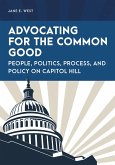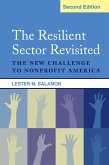Jane E. West
Advocating for the Common Good (eBook, PDF)
People, Politics, Process, and Policy on Capitol Hill
20,95 €
20,95 €
inkl. MwSt.
Sofort per Download lieferbar

10 °P sammeln
20,95 €
Als Download kaufen

20,95 €
inkl. MwSt.
Sofort per Download lieferbar

10 °P sammeln
Jetzt verschenken
Alle Infos zum eBook verschenken
20,95 €
inkl. MwSt.
Sofort per Download lieferbar
Alle Infos zum eBook verschenken

10 °P sammeln
Jane E. West
Advocating for the Common Good (eBook, PDF)
People, Politics, Process, and Policy on Capitol Hill
- Format: PDF
- Merkliste
- Auf die Merkliste
- Bewerten Bewerten
- Teilen
- Produkt teilen
- Produkterinnerung
- Produkterinnerung

Bitte loggen Sie sich zunächst in Ihr Kundenkonto ein oder registrieren Sie sich bei
bücher.de, um das eBook-Abo tolino select nutzen zu können.
Hier können Sie sich einloggen
Hier können Sie sich einloggen
Sie sind bereits eingeloggt. Klicken Sie auf 2. tolino select Abo, um fortzufahren.

Bitte loggen Sie sich zunächst in Ihr Kundenkonto ein oder registrieren Sie sich bei bücher.de, um das eBook-Abo tolino select nutzen zu können.
Advocating for the Common Good: People, Politics, Process, and Policy on Capitol Hill offers a rich and accessible guide to policy making in the nation's capital, beckoning us to get to the table, make our voices heard, and reinvigorate our policy making institutions. Jane E. West parts the curtains and brings us behind the scenes with a simple framework that enables both the novice and the experienced to deftly navigate the Washington maze. The four Ps-people, politics, process, and policy-are each examined with an eye toward what a successful advocate needs to know. Informed by her forty…mehr
- Geräte: PC
- mit Kopierschutz
- eBook Hilfe
- Größe: 2.23MB
Andere Kunden interessierten sich auch für
![Advocating for the Common Good (eBook, ePUB) Advocating for the Common Good (eBook, ePUB)]() Jane E. WestAdvocating for the Common Good (eBook, ePUB)20,95 €
Jane E. WestAdvocating for the Common Good (eBook, ePUB)20,95 €![The Resilient Sector Revisited (eBook, PDF) The Resilient Sector Revisited (eBook, PDF)]() Lester M SalamonThe Resilient Sector Revisited (eBook, PDF)16,95 €
Lester M SalamonThe Resilient Sector Revisited (eBook, PDF)16,95 €![The Road to a Hunger-Free America (eBook, PDF) The Road to a Hunger-Free America (eBook, PDF)]() Mark WinneThe Road to a Hunger-Free America (eBook, PDF)18,95 €
Mark WinneThe Road to a Hunger-Free America (eBook, PDF)18,95 €![The Soul of Civil Society (eBook, PDF) The Soul of Civil Society (eBook, PDF)]() Don EberlyThe Soul of Civil Society (eBook, PDF)32,95 €
Don EberlyThe Soul of Civil Society (eBook, PDF)32,95 €![Moroccan Women, Activists, and Gender Politics (eBook, PDF) Moroccan Women, Activists, and Gender Politics (eBook, PDF)]() Eve SandbergMoroccan Women, Activists, and Gender Politics (eBook, PDF)35,95 €
Eve SandbergMoroccan Women, Activists, and Gender Politics (eBook, PDF)35,95 €![Concentration and Power in the Food System (eBook, PDF) Concentration and Power in the Food System (eBook, PDF)]() Philip H. HowardConcentration and Power in the Food System (eBook, PDF)20,95 €
Philip H. HowardConcentration and Power in the Food System (eBook, PDF)20,95 €![Restless Citizens (eBook, PDF) Restless Citizens (eBook, PDF)]() Udoh Elijah UdomRestless Citizens (eBook, PDF)30,95 €
Udoh Elijah UdomRestless Citizens (eBook, PDF)30,95 €-
-
-
Advocating for the Common Good: People, Politics, Process, and Policy on Capitol Hill offers a rich and accessible guide to policy making in the nation's capital, beckoning us to get to the table, make our voices heard, and reinvigorate our policy making institutions. Jane E. West parts the curtains and brings us behind the scenes with a simple framework that enables both the novice and the experienced to deftly navigate the Washington maze. The four Ps-people, politics, process, and policy-are each examined with an eye toward what a successful advocate needs to know. Informed by her forty years of experience as part of the policy making apparatus in education and disability, expert interviews with those in the room where it happens, a deep dive into congressional procedures, and the scholarship on public policy, Dr. West delivers a powerful call to action. This jargon-free guide provides students, professionals, and the public with practical tools and a proven step-by-step process to both analyze existing policies and plan advocacy strategies to change policies moving forward.
Produktdetails
- Produktdetails
- Verlag: Bloomsbury eBooks US
- Seitenzahl: 198
- Erscheinungstermin: 17. Mai 2023
- Englisch
- ISBN-13: 9798216269892
- Artikelnr.: 74832648
- Verlag: Bloomsbury eBooks US
- Seitenzahl: 198
- Erscheinungstermin: 17. Mai 2023
- Englisch
- ISBN-13: 9798216269892
- Artikelnr.: 74832648
- Herstellerkennzeichnung Die Herstellerinformationen sind derzeit nicht verfügbar.
Jane West is an independent education policy consultant based in Washington, DC. She began her policy work as an intern in the U.S. Senate for Sen. Lowell P. Weicker (R-CT) in 1983, where she went on to serve as staff director for the Subcommittee on Disability Policy of the Committee on Health, Education, Labor and Pensions (HELP). She has been active in policy making for over forty years, working for a range of federal government agencies as well as national organizations, including the Presidential Task Force on the HIV Epidemic, the National Council on Disability, the Social Security Administration, the U.S. Department of Education, the American Association of Colleges for Teacher Education, the Joseph P. Kennedy Jr. Foundation, the National Network of State Teachers of the Year, the Higher Education Consortium for Special Education, and the Teacher Education Division of the Council for Exceptional Children.
She has written and spoken extensively on policy and advocacy in education and disability and served on the faculties of the University of San Francisco, Johns Hopkins University, the University of Maryland, and Virginia Commonwealth University, designing and teaching public policy courses.
For more information, see https://www.janewestconsulting.com
She has written and spoken extensively on policy and advocacy in education and disability and served on the faculties of the University of San Francisco, Johns Hopkins University, the University of Maryland, and Virginia Commonwealth University, designing and teaching public policy courses.
For more information, see https://www.janewestconsulting.com
List of Tables, Textboxes, and Figures
Acknowledgments
Author's Note
Introduction
1 People
The Iron Triangle
Congress Congressional Staff and Congressional CommitteesRelationships Are
EverythingThe Executive BranchInterest GroupsProfessional and Trade
AssociationsBusiness or Corporation AssociationsPublic Interest GroupsThink
TanksWhat Do Interest Groups Do in Relation to Policy and
Advocacy?Political Action Committees and 501 (c) (4)s CoalitionsGovernment
Relations/Lobbying Firms LobbyingBeyond the Iron Triangle
The CourtsSocial Media and the PressPublic OpinionConstituentsGrass Roots
Movements and OrganizationsExperts The Culture of Policy Making vs. the
Cultures of Other Sectors
Representation Matters
Takeaways: People
2 Politics
Majorities and Minorities in Congress
Seniority in CongressThe White House
Election Cycles
Participating in Election Campaigns
Transition to Office after Winning an Election
Bipartisanship
Takeaways: Politics
3 Process
Part I: Summary of the Literature on Public Policy Making Processes
Framework #1: The Cyclical FrameworkProblem DefinitionAgenda SettingPolicy
FormulationPolicy AdoptionPolicy ImplementationPolicy Evaluation Framework
#2: Policy Streams Part II: Congressional Procedures
How a Bill Becomes a Law: The Seven Steps of Regular OrderBill
IntroductionThe Committee Receives the Bill Possible Referral to
SubcommitteeHearings and MarkupsFloor ConsiderationConference
CommitteePresident's SignatureThree Core Legislative Processes: Budget,
Appropriations, AuthorizationBudget Process ReconciliationDeeming
ResolutionsAppropriations ProcessMandatory and Discretionary
SpendingEarmarksAuthorization ProcessOther Congressional ProcessesOversight
and InvestigationsConfirmationsSenate and House RulesCommittee on Rules of
the House of RepresentativesFilibuster and Cloture in the SenatePart III:
Executive Branch Processes
Executive OrdersFederal Rule Making Before the Proposed RuleThe Proposed
RuleBefore the Final RuleThe Final Rule After the Final Rule Negotiated
Rule MakingOther Key Federal Agency Functions Related to Policy
MakingGuidance Takeaways: Process
4 Policy
Which Comes First: The Problem or the Solution?
Policy Tools
GrantsAppropriationsCivil RightsAccountabilityData CollectionEnforcement
MechanismsResearchIndividual BenefitsTax CodeRequirements Related to
Implementation by Federal AgencyWhat is Good Policy?
The Americans with Disabilities Act and the Use of Standardized Assessments
in Federal Education Policy: Point/Counterpoint The ADA: A Remarkable
PolicyNCLB and Its Derivatives: The Use of Standardized Assessments in
Federal Education Policy-a Cautionary Tale Race to the Top 2009Teacher
Preparation Regulations 2011-2017Lessons LearnedTakeaways: Policy
5 Advocacy
Advocating with Congressional Offices
First and Foremost: Build a RelationshipPrepare for MeetingsProvide
Background Information, Data, and StoriesRefine Your Message So It Will Be
Heard by Your AudienceBe Prepared with No More than Three "Asks"Offer
Invitations to Speak or VisitDon't Get Mad or Argue or Talk Politics Always
Follow UpKeep Showing Up Add Your Voice to a National
OrganizationAdvocating with the Executive Branch
Artifacts for Advocacy
Committee and Subcommittee Activities: Hearings, Markups, and MoreOther
Statements from Members of CongressStatus of Bills IntroducedReports from
the Congressional Research ServiceDocuments from the Government
Accountability OfficeDevelopments from the White House and Federal Agencies
Connecting Research, Practice, and Policy
Participating in a Committee Hearing or a Town Hall Meeting
Impact of the COVID-19 Pandemic on Advocacy Activities
Impact of the January 6, 2021, Events at the Capitol on Security Measures
In Closing
Takeaways: Advocacy
Wrapping Up
References
Index
About the Interviewees
About the Author
Acknowledgments
Author's Note
Introduction
1 People
The Iron Triangle
Congress Congressional Staff and Congressional CommitteesRelationships Are
EverythingThe Executive BranchInterest GroupsProfessional and Trade
AssociationsBusiness or Corporation AssociationsPublic Interest GroupsThink
TanksWhat Do Interest Groups Do in Relation to Policy and
Advocacy?Political Action Committees and 501 (c) (4)s CoalitionsGovernment
Relations/Lobbying Firms LobbyingBeyond the Iron Triangle
The CourtsSocial Media and the PressPublic OpinionConstituentsGrass Roots
Movements and OrganizationsExperts The Culture of Policy Making vs. the
Cultures of Other Sectors
Representation Matters
Takeaways: People
2 Politics
Majorities and Minorities in Congress
Seniority in CongressThe White House
Election Cycles
Participating in Election Campaigns
Transition to Office after Winning an Election
Bipartisanship
Takeaways: Politics
3 Process
Part I: Summary of the Literature on Public Policy Making Processes
Framework #1: The Cyclical FrameworkProblem DefinitionAgenda SettingPolicy
FormulationPolicy AdoptionPolicy ImplementationPolicy Evaluation Framework
#2: Policy Streams Part II: Congressional Procedures
How a Bill Becomes a Law: The Seven Steps of Regular OrderBill
IntroductionThe Committee Receives the Bill Possible Referral to
SubcommitteeHearings and MarkupsFloor ConsiderationConference
CommitteePresident's SignatureThree Core Legislative Processes: Budget,
Appropriations, AuthorizationBudget Process ReconciliationDeeming
ResolutionsAppropriations ProcessMandatory and Discretionary
SpendingEarmarksAuthorization ProcessOther Congressional ProcessesOversight
and InvestigationsConfirmationsSenate and House RulesCommittee on Rules of
the House of RepresentativesFilibuster and Cloture in the SenatePart III:
Executive Branch Processes
Executive OrdersFederal Rule Making Before the Proposed RuleThe Proposed
RuleBefore the Final RuleThe Final Rule After the Final Rule Negotiated
Rule MakingOther Key Federal Agency Functions Related to Policy
MakingGuidance Takeaways: Process
4 Policy
Which Comes First: The Problem or the Solution?
Policy Tools
GrantsAppropriationsCivil RightsAccountabilityData CollectionEnforcement
MechanismsResearchIndividual BenefitsTax CodeRequirements Related to
Implementation by Federal AgencyWhat is Good Policy?
The Americans with Disabilities Act and the Use of Standardized Assessments
in Federal Education Policy: Point/Counterpoint The ADA: A Remarkable
PolicyNCLB and Its Derivatives: The Use of Standardized Assessments in
Federal Education Policy-a Cautionary Tale Race to the Top 2009Teacher
Preparation Regulations 2011-2017Lessons LearnedTakeaways: Policy
5 Advocacy
Advocating with Congressional Offices
First and Foremost: Build a RelationshipPrepare for MeetingsProvide
Background Information, Data, and StoriesRefine Your Message So It Will Be
Heard by Your AudienceBe Prepared with No More than Three "Asks"Offer
Invitations to Speak or VisitDon't Get Mad or Argue or Talk Politics Always
Follow UpKeep Showing Up Add Your Voice to a National
OrganizationAdvocating with the Executive Branch
Artifacts for Advocacy
Committee and Subcommittee Activities: Hearings, Markups, and MoreOther
Statements from Members of CongressStatus of Bills IntroducedReports from
the Congressional Research ServiceDocuments from the Government
Accountability OfficeDevelopments from the White House and Federal Agencies
Connecting Research, Practice, and Policy
Participating in a Committee Hearing or a Town Hall Meeting
Impact of the COVID-19 Pandemic on Advocacy Activities
Impact of the January 6, 2021, Events at the Capitol on Security Measures
In Closing
Takeaways: Advocacy
Wrapping Up
References
Index
About the Interviewees
About the Author
List of Tables, Textboxes, and Figures
Acknowledgments
Author's Note
Introduction
1 People
The Iron Triangle
Congress Congressional Staff and Congressional CommitteesRelationships Are
EverythingThe Executive BranchInterest GroupsProfessional and Trade
AssociationsBusiness or Corporation AssociationsPublic Interest GroupsThink
TanksWhat Do Interest Groups Do in Relation to Policy and
Advocacy?Political Action Committees and 501 (c) (4)s CoalitionsGovernment
Relations/Lobbying Firms LobbyingBeyond the Iron Triangle
The CourtsSocial Media and the PressPublic OpinionConstituentsGrass Roots
Movements and OrganizationsExperts The Culture of Policy Making vs. the
Cultures of Other Sectors
Representation Matters
Takeaways: People
2 Politics
Majorities and Minorities in Congress
Seniority in CongressThe White House
Election Cycles
Participating in Election Campaigns
Transition to Office after Winning an Election
Bipartisanship
Takeaways: Politics
3 Process
Part I: Summary of the Literature on Public Policy Making Processes
Framework #1: The Cyclical FrameworkProblem DefinitionAgenda SettingPolicy
FormulationPolicy AdoptionPolicy ImplementationPolicy Evaluation Framework
#2: Policy Streams Part II: Congressional Procedures
How a Bill Becomes a Law: The Seven Steps of Regular OrderBill
IntroductionThe Committee Receives the Bill Possible Referral to
SubcommitteeHearings and MarkupsFloor ConsiderationConference
CommitteePresident's SignatureThree Core Legislative Processes: Budget,
Appropriations, AuthorizationBudget Process ReconciliationDeeming
ResolutionsAppropriations ProcessMandatory and Discretionary
SpendingEarmarksAuthorization ProcessOther Congressional ProcessesOversight
and InvestigationsConfirmationsSenate and House RulesCommittee on Rules of
the House of RepresentativesFilibuster and Cloture in the SenatePart III:
Executive Branch Processes
Executive OrdersFederal Rule Making Before the Proposed RuleThe Proposed
RuleBefore the Final RuleThe Final Rule After the Final Rule Negotiated
Rule MakingOther Key Federal Agency Functions Related to Policy
MakingGuidance Takeaways: Process
4 Policy
Which Comes First: The Problem or the Solution?
Policy Tools
GrantsAppropriationsCivil RightsAccountabilityData CollectionEnforcement
MechanismsResearchIndividual BenefitsTax CodeRequirements Related to
Implementation by Federal AgencyWhat is Good Policy?
The Americans with Disabilities Act and the Use of Standardized Assessments
in Federal Education Policy: Point/Counterpoint The ADA: A Remarkable
PolicyNCLB and Its Derivatives: The Use of Standardized Assessments in
Federal Education Policy-a Cautionary Tale Race to the Top 2009Teacher
Preparation Regulations 2011-2017Lessons LearnedTakeaways: Policy
5 Advocacy
Advocating with Congressional Offices
First and Foremost: Build a RelationshipPrepare for MeetingsProvide
Background Information, Data, and StoriesRefine Your Message So It Will Be
Heard by Your AudienceBe Prepared with No More than Three "Asks"Offer
Invitations to Speak or VisitDon't Get Mad or Argue or Talk Politics Always
Follow UpKeep Showing Up Add Your Voice to a National
OrganizationAdvocating with the Executive Branch
Artifacts for Advocacy
Committee and Subcommittee Activities: Hearings, Markups, and MoreOther
Statements from Members of CongressStatus of Bills IntroducedReports from
the Congressional Research ServiceDocuments from the Government
Accountability OfficeDevelopments from the White House and Federal Agencies
Connecting Research, Practice, and Policy
Participating in a Committee Hearing or a Town Hall Meeting
Impact of the COVID-19 Pandemic on Advocacy Activities
Impact of the January 6, 2021, Events at the Capitol on Security Measures
In Closing
Takeaways: Advocacy
Wrapping Up
References
Index
About the Interviewees
About the Author
Acknowledgments
Author's Note
Introduction
1 People
The Iron Triangle
Congress Congressional Staff and Congressional CommitteesRelationships Are
EverythingThe Executive BranchInterest GroupsProfessional and Trade
AssociationsBusiness or Corporation AssociationsPublic Interest GroupsThink
TanksWhat Do Interest Groups Do in Relation to Policy and
Advocacy?Political Action Committees and 501 (c) (4)s CoalitionsGovernment
Relations/Lobbying Firms LobbyingBeyond the Iron Triangle
The CourtsSocial Media and the PressPublic OpinionConstituentsGrass Roots
Movements and OrganizationsExperts The Culture of Policy Making vs. the
Cultures of Other Sectors
Representation Matters
Takeaways: People
2 Politics
Majorities and Minorities in Congress
Seniority in CongressThe White House
Election Cycles
Participating in Election Campaigns
Transition to Office after Winning an Election
Bipartisanship
Takeaways: Politics
3 Process
Part I: Summary of the Literature on Public Policy Making Processes
Framework #1: The Cyclical FrameworkProblem DefinitionAgenda SettingPolicy
FormulationPolicy AdoptionPolicy ImplementationPolicy Evaluation Framework
#2: Policy Streams Part II: Congressional Procedures
How a Bill Becomes a Law: The Seven Steps of Regular OrderBill
IntroductionThe Committee Receives the Bill Possible Referral to
SubcommitteeHearings and MarkupsFloor ConsiderationConference
CommitteePresident's SignatureThree Core Legislative Processes: Budget,
Appropriations, AuthorizationBudget Process ReconciliationDeeming
ResolutionsAppropriations ProcessMandatory and Discretionary
SpendingEarmarksAuthorization ProcessOther Congressional ProcessesOversight
and InvestigationsConfirmationsSenate and House RulesCommittee on Rules of
the House of RepresentativesFilibuster and Cloture in the SenatePart III:
Executive Branch Processes
Executive OrdersFederal Rule Making Before the Proposed RuleThe Proposed
RuleBefore the Final RuleThe Final Rule After the Final Rule Negotiated
Rule MakingOther Key Federal Agency Functions Related to Policy
MakingGuidance Takeaways: Process
4 Policy
Which Comes First: The Problem or the Solution?
Policy Tools
GrantsAppropriationsCivil RightsAccountabilityData CollectionEnforcement
MechanismsResearchIndividual BenefitsTax CodeRequirements Related to
Implementation by Federal AgencyWhat is Good Policy?
The Americans with Disabilities Act and the Use of Standardized Assessments
in Federal Education Policy: Point/Counterpoint The ADA: A Remarkable
PolicyNCLB and Its Derivatives: The Use of Standardized Assessments in
Federal Education Policy-a Cautionary Tale Race to the Top 2009Teacher
Preparation Regulations 2011-2017Lessons LearnedTakeaways: Policy
5 Advocacy
Advocating with Congressional Offices
First and Foremost: Build a RelationshipPrepare for MeetingsProvide
Background Information, Data, and StoriesRefine Your Message So It Will Be
Heard by Your AudienceBe Prepared with No More than Three "Asks"Offer
Invitations to Speak or VisitDon't Get Mad or Argue or Talk Politics Always
Follow UpKeep Showing Up Add Your Voice to a National
OrganizationAdvocating with the Executive Branch
Artifacts for Advocacy
Committee and Subcommittee Activities: Hearings, Markups, and MoreOther
Statements from Members of CongressStatus of Bills IntroducedReports from
the Congressional Research ServiceDocuments from the Government
Accountability OfficeDevelopments from the White House and Federal Agencies
Connecting Research, Practice, and Policy
Participating in a Committee Hearing or a Town Hall Meeting
Impact of the COVID-19 Pandemic on Advocacy Activities
Impact of the January 6, 2021, Events at the Capitol on Security Measures
In Closing
Takeaways: Advocacy
Wrapping Up
References
Index
About the Interviewees
About the Author







